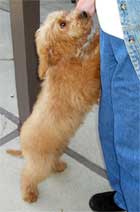ATTENTION SEEKING BEHAVIOURS REVEALED
By Louise Thompson
Accredited Animal Behaviour Consultant (ABC of SA ©®™)
From a dogs point of view, if a behaviour is successful, (which means that the dog is rewarded – even if it is unintentional - for exhibiting a particular behaviour), then he will repeat the behaviour.
Reward, to a dog, can be one of many things, the most important being receiving attention from his owner or pack leader! Most dogs even perceive negative attention as rewarding. Negative attention could be perceived as any response to a behaviour.
Dogs that constantly demand attention from their owners have learnt that this behaviour is successful. More often than not, the more attention they demand, the more attention the owners give – if only to keep the peace.
Attention seeking behaviour can present in many forms such as:-
In this regard, dogs are also often receive conflicting signals from their owners – thus adding to their confusion and indirectly encouraging the behaviour – if only to receive a response.
Attention seeking dogs often are low ranking individuals, given owner status that they have not earned – this also causes confusion and encourages negative behaviours and dissention in a pack.
Anthropomorphism (accrediting animals with human feelings and emotions) causes insecure, unhappy dogs.
WAYS TO REDUCE OR ELIMINATE ATTENTION SEEKING BEHAVIOUR:
Reward, to a dog, can be one of many things, the most important being receiving attention from his owner or pack leader! Most dogs even perceive negative attention as rewarding. Negative attention could be perceived as any response to a behaviour.
Dogs that constantly demand attention from their owners have learnt that this behaviour is successful. More often than not, the more attention they demand, the more attention the owners give – if only to keep the peace.
Attention seeking behaviour can present in many forms such as:-
- Demanding to be stroked
- Nudging for a stroke
- Pawing
- Resting his head on your lap for a stroke
- Constantly demanding to be let in / out
- Demanding food / water
- Refusal to eat – especially in the hope of being hand fed in overindulged cases.
- Begging
- Vocalisation (the reward is the owners yelling “shut up”
- Vocalisation when the owner is on the telephone.
- Toy control
- Demanding to play (with or without toys)
- Demanding to go for a walk (ritualised behaviours)
- Begging at the table
- Physical exhibition of neurosis – to receive a response or comfort (shivering etc)
- Jumping up and excitable behaviour
- Some destructive behaviour.
- Leash forging (pulling on the lead)
- Jumping up against you to be picked up or carried.
In this regard, dogs are also often receive conflicting signals from their owners – thus adding to their confusion and indirectly encouraging the behaviour – if only to receive a response.
Attention seeking dogs often are low ranking individuals, given owner status that they have not earned – this also causes confusion and encourages negative behaviours and dissention in a pack.
Anthropomorphism (accrediting animals with human feelings and emotions) causes insecure, unhappy dogs.
WAYS TO REDUCE OR ELIMINATE ATTENTION SEEKING BEHAVIOUR:
- Ignore negative behaviour and only reward and react to “good” or positive behaviours.
- Use the “doggie time out” principles – which include – If the dog wants to be included in YOUR pack he has to abide by your rules.
- Become a good leader and decision maker – do not let the dog make any decisions. This will make you more valuable, reduce much doggy stress, and make your dog feel more secure as it lifts much (decision making / high ranking) responsibilities off his shoulders.
- Ensure that you initiate any contact with the dog – for example, if your dog comes and demands to play ignore him until he stops demanding. Wait a couple of minutes and then call him for a game. In this way you have taken control, been the decision maker and rewarded the dog be encouraging the “good” behaviour to be repeated (as when he was calm and quiet – you then called him for a game)
- Follow the “Dogs Boss” instructions as provided earlier.
- Distraction techniques can also be fully utilised especially “startle” responses as previously described.
You may also enjoy.....
Separation Anxiety - what to do
Alone Time for your dog
FOTD Dog Behaviour Spray - Separation Anxiety
Alone Time for your dog
FOTD Dog Behaviour Spray - Separation Anxiety
This article is copyrighted and remains the property of the author. Individuals are welcome to print or copy same for their own use in furthering their knowledge of dogs. However, no reproductions or alterations/variations are allowed without the express written consent of the author.

